
East Coker is a village and civil parish in the South Somerset district of Somerset, England. Its nearest town is Yeovil, two miles (3.2 km) to the north. The village has a population of 1,667. The parish includes the hamlets and areas of North Coker, Burton, Holywell, Coker Marsh, Darvole, Nash, Keyford as well as the southern end of the Wraxhill area.

Martock is a large village and civil parish in Somerset, England, situated on the edge of the Somerset Levels 7 miles (11.3 km) north west of Yeovil in the South Somerset district. The parish includes Hurst, approximately one mile south of the village, and Bower Hinton, which is located at the western end of the village and bounded by Hurst and the A303. Martock has a population of 4,766 and was historically a market town.

Badminton House is a large country house and Grade I Listed Building in Badminton, Gloucestershire, England, which has been the principal seat of the Dukes of Beaufort since the late 17th century. The house, which has given its name to the sport of badminton, is set among 52,000 acres of land. The gardens and park surrounding the house are listed at Grade I on the Register of Historic Parks and Gardens.
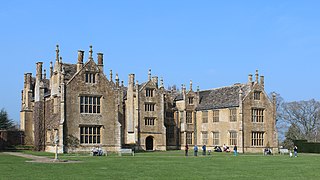
Barrington Court is a Tudor manor house begun around 1538 and completed in the late 1550s, with a vernacular stable court (1675), situated in Barrington, near Ilminster, Somerset, England.
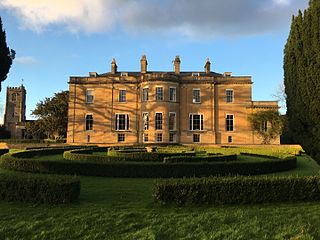
Dinder House, is a Somerset estate with a small country house Grade II Regency listed building in the village of Dinder, in the civil parish of St Cuthbert Out in Somerset. Dinder House was formerly a manor house dating back to the 12th century, but the existing building was constructed between 1799 and 1801 by the Rev William Somerville on the original site. The estate remained as the seat of the Somerville family until the late twentieth century.
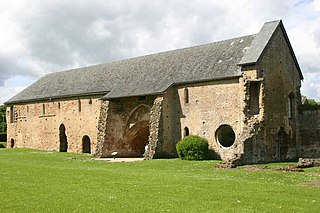
Cleeve Abbey is a medieval monastery located near the village of Washford, in Somerset, England. It is a Grade I listed building and has been scheduled as an ancient monument.
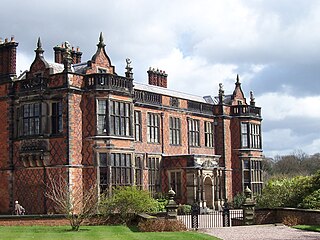
Arley Hall is a country house in the village of Arley, Cheshire, England, about 4 miles (6 km) south of Lymm and 5 miles (8 km) north of Northwich. It is home to the owner, Viscount Ashbrook, and his family. The house is a Grade II* listed building, as is its adjacent chapel. Formal gardens to the southwest of the hall are also listed as Grade II* on the National Register of Historic Parks and Gardens. In the grounds are more listed buildings, a cruck barn being listed as Grade I, and the other buildings as Grade II.
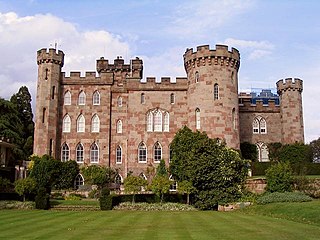
Cholmondeley Castle is a country house in the civil parish of Cholmondeley, Cheshire, England. Together with its adjacent formal gardens, it is surrounded by parkland. The site of the house has been a seat of the Cholmondeley family since the 12th century. The present house replaced a timber-framed hall nearby. It was built at the start of the 19th century for George Cholmondeley, 1st Marquess of Cholmondeley, who designed most of it himself in the form of a crenellated castle. After the death of the Marquess, the house was extended to designs by Robert Smirke to produce the building in its present form. The house is designated by English Heritage as a Grade II* listed building.

Blackford is a village and former civil parish in the county of Somerset, England, beside the A303 road, 4 miles (6.4 km) south west of Wincanton. There are two other places called Blackford in Somerset: one is a village near Wedmore, the other a tiny hamlet in Selworthy parish between Porlock and Minehead.
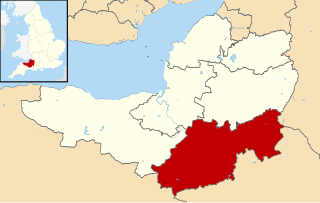
South Somerset is a local government district in the English county of Somerset. The South Somerset district occupies an area of 370 square miles (958 km2), stretching from its borders with Devon and Dorset to the edge of the Somerset Levels. The district has a population of about 158,000, and has Yeovil as its administrative centre.
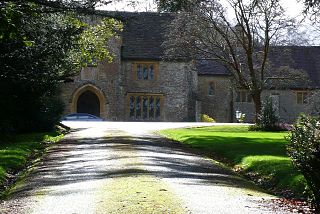
Coker Court is a substantial manor house in East Coker, Somerset, England. It was built in the fifteenth and eighteenth centuries and has been designated as a Grade I listed building. It was erected by the Courtney family who were lords of the manor and rectors of the adjacent parish church. The building is constructed from locally quarried Hamstone with roofs composed of stone tiles.
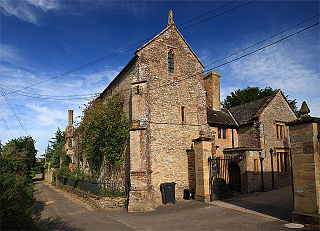
Naish Priory in East Coker, Somerset, England, contains portions of a substantial house dating from the mid 14th century to around 1400. Emery says the building was not a priory as it had been termed by the late 19th-century owner Troyte Chafyn Grove, and there appears no evidence of ownership by a religious house or the residence of a large community of monks on the site. However, there is evidence of a dormitory and communal living dating from the 14th century, and the extant buildings grew on a foundation that had religious obligations by way of chantry to the de Courtenay Earls of Devon from at least 1344. It has been designated as a Grade I listed building, with the attached Priory Cottage and northern boundary railings.

The Manor House in West Coker, Somerset, England has medieval origins, however the earliest surviving portions of the current building probably date from around 1500. It has been designated as a Grade I listed building.

Fore Street in Chard, Somerset, England was built in the late 16th and early 17th century, following a fire which destroyed much of the town in 1577.

West Somerset is a local government district in the county of Somerset which is in South West England. In the United Kingdom, the term listed building refers to a building or other structure officially designated as being of special architectural, historical or cultural significance; Grade II* structures are those considered to be "particularly significant buildings of more than local interest". Listing was begun by a provision in the Town and Country Planning Act 1947. Once listed, severe restrictions are imposed on the modifications allowed to a building's structure or its fittings. In England, the authority for listing under the Planning Act 1990 rests with Historic England, a non-departmental public body sponsored by the Department for Digital, Culture, Media and Sport; local authorities have a responsibility to regulate and enforce the planning regulations.
Brough is a civil parish in the Eden District, Cumbria, England. It contains 39 buildings that are recorded in the National Heritage List for England. Of these, one is listed at Grade II*, the middle of the three grades, and the others are at Grade II, the lowest grade. The parish contains the village of Brough, at the junction of the A66 and the A685 roads, and the surrounding countryside. Most of the listed buildings are shops and houses with associated structures in the village. The other listed buildings include a church, a memorial in the churchyard, three cross bases, a hotel, a farmhouse, three boundary stones, three mileposts, a clock tower, and a bridge.

Shotover Park is an 18th-century country house and park near Wheatley, Oxfordshire, England. The house, garden and parkland are Grade I-listed with English Heritage, and 18 additional structures on the property are also listed. Shotover House, its gardens, parkland and the wider estate are privately owned by the Shotover Trust. Shotover Park which lies on the north and east slopes of Shotover hill should not be confused with the more recently named Shotover Country Park, which is a public park and nature reserve on the southwest slopes of Shotover hill managed by Oxford City Council.
Hazel Grove and Bramhall are towns in the Metropolitan Borough of Stockport, Greater Manchester, England. The towns, together with the village of Woodford, contain 29 listed buildings that are recorded in the National Heritage List for England. Of these, one is listed at Grade I, the highest of the three grades, one is at Grade II*, the middle grade, and the others are at Grade II, the lowest grade. Most of the listed buildings are houses and associated structures, farmhouses and farm buildings. The other listed buildings include churches and lych gates, and two war memorials.
Woolley is a civil parish in the metropolitan borough of the City of Wakefield, West Yorkshire, England. The parish contains 38 listed buildings that are recorded in the National Heritage List for England. Of these, one is listed at Grade I, the highest of the three grades, one is at Grade II*, the middle grade, and the others are at Grade II, the lowest grade. The parish contains the village of Woolley and the surrounding area. Apart from the Grade I listed church, the most important building in the parish is Woolley Hall, which is listed together with associated structures and items in its grounds. The other listed buildings include items in the churchyard, houses, cottages and associated structures, farmhouses and farm buildings, some of which have been converted into dwellings, a sheep dip, former schools, and a water cistern cover.

















